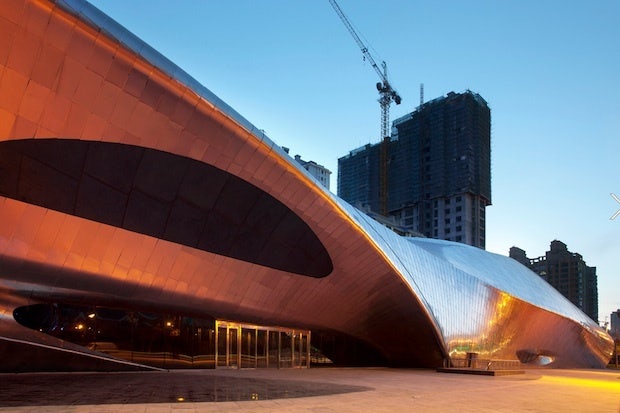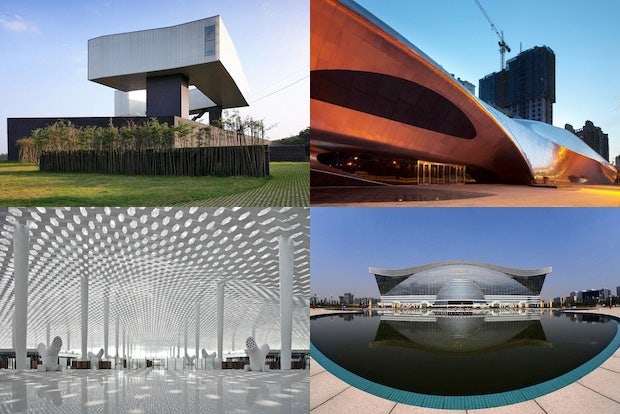
With its ever-growing skylines and architecture with a penchant for the superlative—the biggest, tallest, and most innovative, China's impressive physical transformation has matched its ambitious economic development during the past two decades. Along with the impressive speed and grand scales in which infrastructural developments such as highways and high-speed railroads are being constructed, bold new forms by “starchitects” have appeared on the horizons of China’s megacities.
Airports, stadiums, shopping malls, towers, and residential complexes are being built not only within historic cores of cities, but also replacing former farmlands and rural townships on the fringes of urban boundaries. Much of this construction has been fueled by private real-estate speculation, government-sponsored infrastructural development, housing programs, and rural-to-urban migration.
Despite years of booming development, Chinese officials have begun to reign in its free-spending ways to combat mounting local government debt levels that has contributed to lower-than-expected GDP growth seen this summer. Vanity projects end up under-occupied or vacant as ghost towns are also catching the attention of the central government. As reported by Xinhua earlier this year, the Chinese Premier Li Keqiang told a press conference that his government will not use public coffers to construct new offices, halls. or guest houses for government use. Government-funded real-estate ventures will also be more carefully considered. Even with this new government austerity, there is still plenty of room to grow. Home-grown talents along with foreign architects continue to flock to the Middle Kingdom in search of opportunities and gladly offer their vision of a Chinese urbanity. This past year is no different. Here are the top five architectural projects which opened in 2013:
1.#
Sifang Parkland#
Projects by Steven Holl Architects, David Adjaye, Wang Shu, Liu Jiakun, Ai Weiwei,#
Mansilla + Tuñón, SANAA#
Nanjing, China#
Built over the course of 10 years on the outskirts of Nanjing, Sifang Parkland was developed by the 58-year old real-estate developer Lu Jun and his son, Lu Xun. This $164-million development with 11 buildings designed by leading international architects is anchored by the Sifang Art Museum, a 21,528-square-foot space designed by New York architect Steven Holl. The twisting luminescent tube of the art museum, which will exhibit Mr. Lu’s private art collection, serves as the centerpiece in a complex of a hotel, conference center, and residential villas.
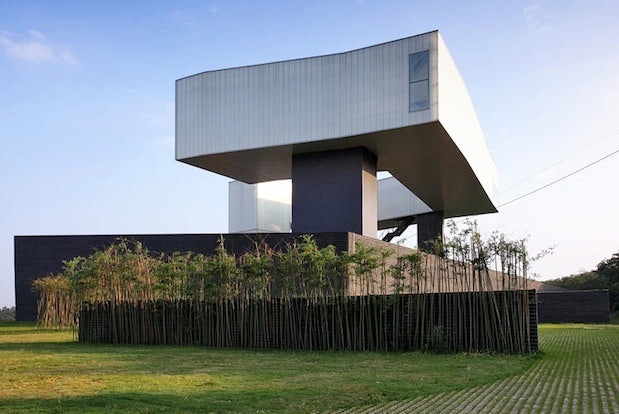
2.#
Shenzhen Bao’an International Airport#
By Studio Fuksas#
Shenzhen, China#
Adding to China’s list of new airports including Sir Norman Foster’s Beijing Terminal 3, the Shenzhen Bao’an International Airport’s new Terminal 3 officially opened in November with its first flight taking off for Mongolia. Designed by Rome-based Studio Fuksas, the new terminal extends for approximately one mile in length. Its skin is clad with a honeycombed-pattern which filters the harsh summer sun along its 260-foot roof span. In spite of its cosmopolitan architectural elegance and abundant passenger capacity, the $1-trillion airport currently serves mostly regional routes and has only one direct flight to Europe—Helsinki. Time will tell whether more airlines will connect to the new airport terminal.
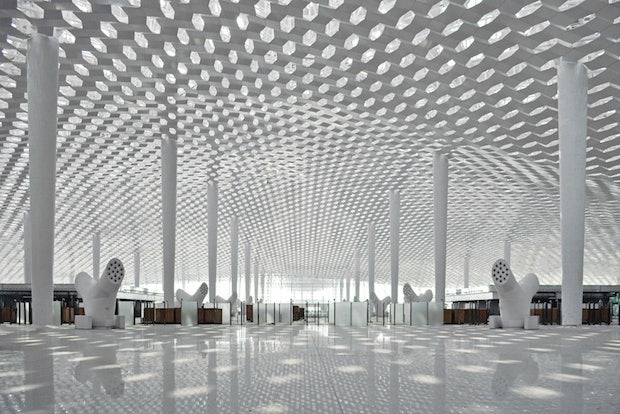
3.#
Shenzhen Stock Exchange#
By Office for Metropolitan Architecture (OMA)#
Shenzhen, China#
After the CCTV Headquarters, or as it's locally-known in Beijing, the “Big Underpants,” the Shenzhen Stock Exchange is the second completed building in China by Rotterdam-based OMA, led by Pritzker-winning architect Rem Koolhaas. The 46-story monolithic tower is defined by its three-story podium, which is elevated 120-feet above the ground. Serving as the main listing halls and offices of the Stock Exchange, the raised podium also shades the public plaza below, which can be accessed from the nearby the Shenzhen City Hall.
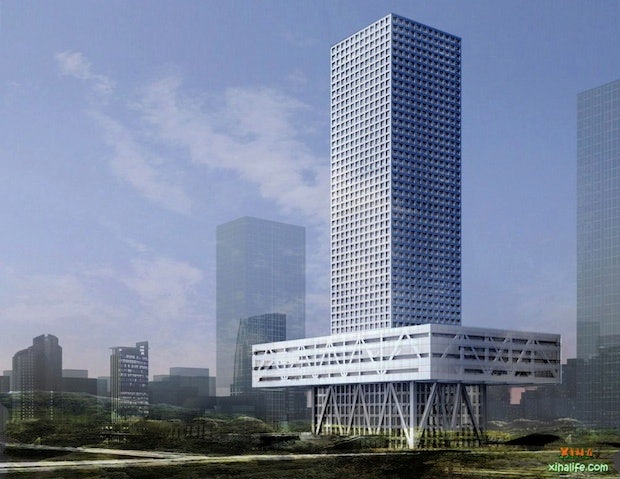
4.#
New Century Global Center#
Chengdu, China#
With an area of 19 million-square-feet, this new shopping mall in Chengdu is almost 4 times the size of the Mall of America in Minnesota. As the world’s largest freestanding building measured by floor space, it is large enough to hold 20 Sydney Opera Houses or 3 Pentagons. Instead, it holds an IMAX theater, shops, restaurants, offices, hotels, conference rooms, a “Mediterranean village,” a pirate ship, and a skating rink. The main feature of the building is an artificial beach, where a 490-by-130-foot screen projects sunrises and sunsets. Despite the scaled-back opening of the mall this year because of corruption investigations into its billionaire developer, Deng Hong, and connected local government officials, the shopping mall has gained considerable media attention. Whether this attention translates into sales and traffic remains to be seen.
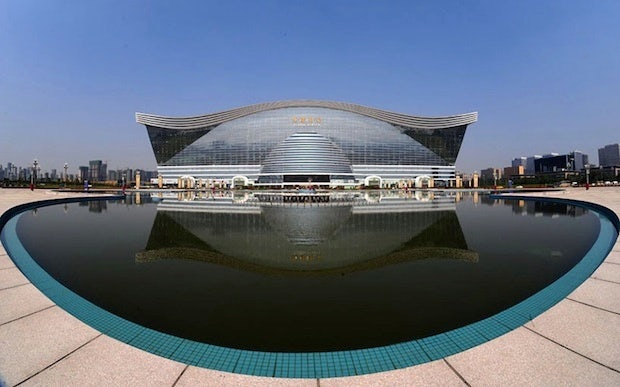
5.#
China Wood Sculpture Museum#
By MAD#
Harbin, China#
Led by Ma Yansong and Dan Qun, the Beijing-based studio of MAD is known for designing fluid geometries and surreal forms. Their latest work, the China Wood Sculpture Museum, appears conspicuously among residential compounds in the city of Harbin. Spanning 650 feet in length, the museum’s twisted form is clad with sleek polished steel panels that mirror and reflects its surroundings. Inside, the museum is to ostensibly house a collection of wood sculptures and paintings depicting ice and snow of the region. However, it is more likely another example of what M+ curator, Aric Chen, points out as “too much hardware and not enough software,” during a recent interview. Chen observes a lack of programing and curatorial infrastructural necessary to support the more than 1,000 museums that have been built during the past decade in China.
